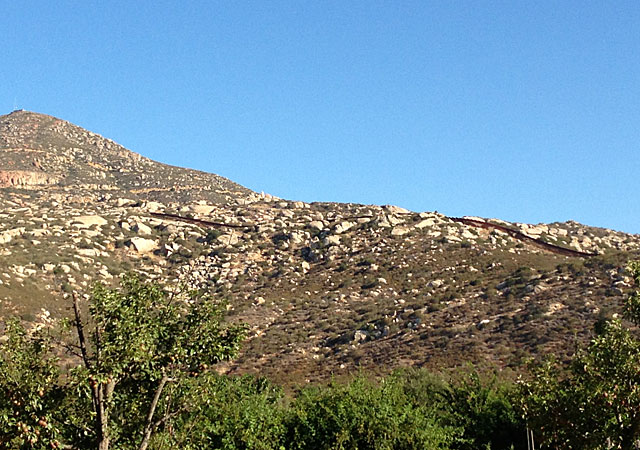US-Mexico border: The ‘Cicatriz’ of Tecate

 By Johanna Mendelson Forman, Voxxi
By Johanna Mendelson Forman, Voxxi
Tecate is a small border town of 65,000 people that serves as a gateway to the Mexican state of Baja California. It is famous for the beer factory that produces the eponymous brew.
The city was founded in 1892. Since that time it has been a center for local agriculture and trade. It never achieved the notoriety of Tijuana, the other border town just south of San Diego.
What distinguishes Tecate, however, is that it is the home of one the world’s sacred mountain, according to scholar Walter Evans-Wentz.
Mount Cuchama, a holy site to the Kumeyaay Indians of San Diego and Baja California, lies southeast of the city of San Diego and just north of Tecate, Mexico. Cuchama, which means “exalted high place” is 3,887 feet high, small when compared to other California mountains of the Sierra Nevada, but it is the highest mountain of the extreme southwestern part of California.
Some offended by Tecate’s “scar”
In 2009 the U.S. government completed construction of a steel border wall on the Mount Cuchama international boundary. The eight-tenths of a mile barrier cuts a swath across the face of Mount Cuchama, which when viewed from the town looks like a scar.
Most people in the town refer to the fence as “la cicatriz de Tecate” (the scar of Tecate). More than a defacing of a scared mountain, the construction of border fences along the U.S. – Mexican border symbolizes a deeper division between two nations whose fates are intertwined by geography, history, and economics.
Tecatenses, as residents of Tecate are called, talk in hushed voices when any mention of the fence is made. During a recent visit to the town, when I asked several people about the barrier many just shook their head in disbelief that such a fence was even needed.
One local mentioned that descendents of the indigenous people, shaman who still live in the town, are deeply offended by the barrier.
The esthetic degradation of a holy site also symbolizes a division rather than friendship between two nations. Workers at one of the city’s main industries, a health spa, Rancho la Puerta, comment on the eye-sore that has been erected on Mount Cuchama.
The spa features hikes for its guests on a daily basis, and holds itself as a defender of the environment in the city. Environmental groups on both sides of the border, including the Sierra Club, have decried the expansion of border fences because of the potential threat to wildlife and damage to flora on the mountainside. (A unique variety of cypress found only on Mt. Cuchama is potentially at risk)
The barrier has been ineffective
Aside from desecrating a holy site, the barrier in Tecate has not been an effective deterrent in the smuggling of drugs or persons that Congress had intended them to be. Tunnels have become a preferred way for getting illicit goods and individuals across to the U.S. In 2007 U.S. Border Patrol agents found a series of tunnels under a shipping container on a piece of property that was located in the center of Tecate.
In late 2012 the Mexican military uncovered a half-finished “narco-tunnel” under a bottling plant after soldiers received an anonymous tip from someone in town about suspicious activities.
The recently approved immigration reform bill in the U.S. Senate was greeted by Mexican officials with mixed emotions.
On the one hand the proposed legislation would offer legalization for more than 11 million unauthorized residents, mostly from Mexico and Central America. But it would also create even greater separation between our countries with the construction of 700 more miles of fencing along the U.S. southwest border at the whopping price tag of $1.5 billion.
Between 2006 and 2009 the Customs and Border Protection spent $2.4 billion to complete 670 miles of fence, mostly a single layer. And if the Congress has its way in 2013 any new fencing will have a double parallel barrier. Additional fencing for difficult terrain, such as the land on Mount Cuchama, would be particularly costly.
Calling the fence on Mt. Cuchama a scar has deeper meaning to those who must view the mountain daily. It reflects a darker side to the U.S.-Mexican relationship that is only going to get worse after the passage of the proposed new immigration law.
The Senate version of the bill approved more money for border patrol agents, doubling the number, required sensing devices, and of course additional fences.
Such sensitivities are not limited to Tecate. Just last month in late June Mexican President Pena Nieto, whose government had long been silent on the issue of barrier walls, reacted to the newest immigration reform bill that passed the Senate. His Minister of Foreign Affairs, Jose Meade, criticized the U.S., stating “We are convinced that fences do not unite [both nations.]. . .

In this July 25, 2009 file photo, a patrol vehicle is seen from the Mexican side of the US-Mexico border, in Tecate. (AP Photo/Guillermo Arias/FILE)
Our country has let the U.S. government know that measures which will affect the links between communities do not coincide with the principles of good neighborship [sic] and shared responsibility,” a riff on the Obama administration’s reference to managing the illegal narcotics trade between our countries.
The irony of the United States Congress’s obsession with fences is that we really live in a world without borders. In an age of cybercrime, when physical barriers no longer protect nation-states from intruders, it is difficult to reconcile the investments being made at the border to keep out drugs and people.
What is being lost, meanwhile, is the need to build trust with a dynamic middle income country, the second largest market for U.S. goods and services. The U.S. and Mexico are joined economies and our nation will is the second largest Spanish speaking country in the world.
Maybe the people of Tecate are on to something when they call the fence a scar. You can disguise a scar temporarily, but it will never really disappear. And for our own legislators, who only feel secure with physical barriers in place, perhaps a re-reading of 20th century American poet Robert Frost is in order.
This article was first published in Voxxi.
Johanna Mendelson Forman is a Scholar-in-Residence at the Center for Strategic and International Studies and a Scholar-in-Residence at the American University, Washington, D.C.
[Photo by VOXXI/Johanna Mendelson Forman]
